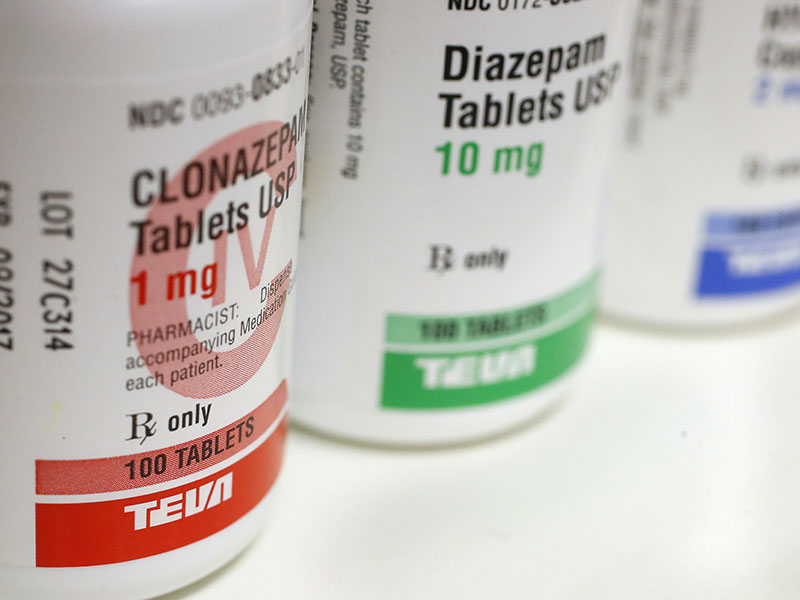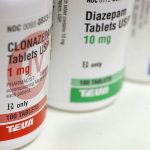Benzodiazepine derivatives – anxiolytics that relieve anxiety, in the old way are called tranquilizers. Drugs in this group enhance the effects of GABA (gamma-amino-butyric acid), the main inhibitory mediator in the central nervous system. Weakly act on serotonin and dopamine receptors. The effects are due to the influence on various parts of the central nervous system: the reticular formation of the brain stem and nonspecific nuclei of the thalamus (sedation), amygdala complexes of the limbic system (anxiolytic), polysynapses of the spinal cord (muscle relaxant) and hippocampus (anticonvulsant). Sedation caused by benzodiazepines is manifested by suppression of the reaction to persistent stimuli with a decrease in the level of thinking and activity. They are characterized by anterograde amnesia, when it is impossible to remember what happened during the action of the drug. At the same time, contact with the patient is maintained. This complication, by the way, can be very convenient for unpleasant medical procedures, including chemotherapy. The drugs of this group are anesthetics and, in combination with other drugs, can be used in palliative oncology as pain relievers.
The presence of very beneficial properties has caused overuse of these drugs, which leads to psychological and physical dependence. In the early 1990s, benzodiazepines were the 18th-20th most consumed drugs in the United States.
Diazepam (sibazone, seduxen, relanium) can be useful for stopping delayed vomiting, since it has an injectable form. Diazepam is more lipophilic than lorazepam, so the effects of the latter on the central nervous system are delayed. The rate of metabolic transformation and elimination is too low, so the main effects are long lasting. The half-life of lorazepam is from 10 to 18 hours, diazepam is 48-150 hours, and phenozepam is up to 18 hours.
Long half-lives can lead to undesirable excessive depression of the central nervous system and are due to the formation of active forms of metabolites. The half-life of diazepam increases with age, but its elimination from the body remains constant. On the other hand, the shorter the elimination half-life, the more severe the “withdrawal” syndrome inherent in tranquilizers, since the trace concentrations of the drug remain in the plasma for a long time. Withdrawal is strongly reminiscent of an alcoholic hangover. For drugs in this group, pronounced cross-dependence is characteristic, when withdrawal symptoms caused, for example, by lorazepam, can be stopped by taking diazepam or fenozepam, and vice versa. Classical physical dependence, however, develops very rarely, only with long-term administration of very high doses, for diazepam it is 8-10 tablets per day for more than 2-3 months. For most sleeping pills (except benzodiazepines), a dose 10 times the sleeping pill can be lethal. There is an antidote for benzodiazepines – flumazenil. But the main disadvantage of benzodiazepines is the increased depression of the central nervous system when taken together with other sedative-hypnotics or alcohol.
List of Benzodiazepines and Designer Drugs:
| Drug name | Common trade names | Year approved (US FDA) | Approx. equivalent oral doses to 10 mg diazepam (mg) | Time to peak onset of action(hours) | Elimination half-life of active metabolite (hours) | Therapeutic use |
|---|---|---|---|---|---|---|
| Adinazolam | Deracyn | Research chemical | 1–2 | 3 | anxiolytic, antidepressant | |
| Alprazolam | Xanax, Helex, Xanor, Trankimazin, Onax, Alprox, Misar, Restyl, Solanax, Tafil, Neurol, Frontin, Kalma, Ksalol | 1981 | 0.25 | 1–2 | 10–20 | anxiolytic, antidepressant |
| Bentazepam | Thiadipona | 1–3 | 2–4 | anxiolytic | ||
| Bretazenil | 2.5 | anxiolytic, anticonvulsant | ||||
| Bromazepam | Lectopam, Lexaurin, Lexatin, Lexotanil, Lexotan, Bromam | 1981 | 6 | 1–3 | 20–40 | anxiolytic,hypnotic |
| Bromazolam | Research chemical | anxiolytic | ||||
| Brotizolam | Lendormin, Dormex, Sintonal, Noctilan | 0.5–2 | 4–5 | hypnotic | ||
| Camazepam | Albego, Limpidon, Paxor | 0.5–2 | 6–29 | anxiolytic | ||
| Chlordiazepoxide | Librium, Risolid, Elenium | 1960 | 25 | 1.5–4 | 5–200 | anxiolytic |
| Cinazepam | Levana | 2–4 | 60 | hypnotic, anxiolytic | ||
| Cinolazepam | Gerodorm | 0.5–2 | 9 | hypnotic | ||
| Clobazam | Onfi, Frisium, Urbanol | 2011 | 1–3 | 8–60 | anxiolytic, anticonvulsant | |
| Clonazepam | Rivatril, Rivotril, Klonopin, Iktorivil, Paxam | 1975 | 0.5 | 1–4 | 19.5–50 | anticonvulsant, anxiolytic, muscle relaxant |
| Clonazolam | Research chemical | 0.2 | 0.5–1.5 | 10–18 | anxiolytic, anticonvulsant, hypnotic, muscle relaxant | |
| Clorazepate | Tranxene, Tranxilium | 1972 | 20 | Variable | 32–152 | anxiolytic, anticonvulsant |
| Clotiazepam | Veratran, Clozan, Rize | 1–3 | 4 | anxiolytic | ||
| Cloxazolam | Sepazon, Olcadil | 2–5 | 80–105 | anxiolytic, anticonvulsant | ||
| Delorazepam | Dadumir | 1–2 | 80–105 | anxiolytic, amnesic | ||
| Deschloroetizolam | Research chemical | anxiolytic | ||||
| Diazepam | Antenex, Apaurin, Apzepam, Apozepam, Diazepan, Hexalid, Normabel, Pax, Stesolid, Stedon, Tranquirit, Valium, Vival, Valaxona | 1963 | 10 | 1–1.5 | 32–205 | anxiolytic, anticonvulsant, muscle relaxant, amnesic |
| Diclazepam | Research chemical | 1.5–3 | 42 | anxiolytic, amnesic, anticonvulsant, hypnotic, muscle relaxant | ||
| Estazolam | ProSom, Nuctalon | 1990 | 1–5 | 10–31 | hypnotic, anxiolytic | |
| Ethyl carfluzepate | Not approved | 1–5 | 11–24 | hypnotic | ||
| Etizolam | Etilaam, Etizest, Pasaden, Depas | Often sold as a research chemical, but is approved for human use in many countries. Controlled substance in some US states, Canada, Germany, Austria, and others. | 1–2 | 1–2 | 6 | anxiolytic, hypnotic, amnesic, muscle relaxant, anticonvulsant |
| Ethyl loflazepate | Victan, Meilax, Ronlax | 2 | 2.5–3 | 73–119 | anxiolytic | |
| Flualprazolam | Research chemical | hypnotic, anxiolytic | ||||
| Flubromazepam | Research chemical | 1.5–8 | 100–220 | anxiolytic, hypnotic, amnesic, muscle relaxant, anticonvulsant | ||
| Flubromazolam | Research chemical | hypnotic | ||||
| Fluclotizolam | Research chemical | hypnotic | ||||
| Flunitrazepam | Rohypnol, Hipnosedon, Vulbegal, Fluscand, Flunipam, Ronal, Rohydorm, Hypnodorm | Not approved | 1 | 0.5–3 | 18–200 | hypnotic |
| Flunitrazolam | Research chemical | hypnotic | ||||
| Flurazepam | Dalmadorm, Dalmane, Fluzepam | 1970 | 15 | 1–1.5 | 40–250 | hypnotic |
| Flutazolam | Coreminal | 3.5 | hypnotic | |||
| Flutoprazepam | Restas | Research chemical | 0.5–9 | 60–90 | hypnotic, anticonvulsant | |
| Halazepam | Paxipam | 1981 | 20 | 1–3 | 30–100 | anxiolytic |
| Ketazolam | Anxon | Not approved | 20 | 2.5–3 | 30–200 | anxiolytic |
| Loprazolam | Dormonoct | 1.5 | 0.5–4 | 3–15 | hypnotic | |
| Lorazepam | Ativan, Orfidal, Lorenin, Lorsilan, Temesta, Tavor, Lorabenz | 1977 | 1 | 2–4 | 10–20 | anxiolytic, amnesic, anticonvulsant, hypnotic, muscle relaxant |
| Lormetazepam | Loramet, Noctamid, Pronoctan | 1 | 0.5–2 | 10 | hypnotic | |
| Meclonazepam | Research chemical | anxiolytic | ||||
| Medazepam | Nobrium, Ansilan, Mezapam, Rudotel, Raporan | 10 | 1–1.5 | 36–200 | anxiolytic | |
| Metizolam | Research chemical | 2–4 | 12 | anxiolytic, hypnotic, amnesic, muscle relaxant, anticonvulsant | ||
| Mexazolam | Melex, Sedoxil | 1–2 | anxiolytic | |||
| Midazolam | Dormicum, Versed, Hypnovel, Dormonid | 1985 | 10 (oral)4 (IV) | 0.5–1 | 1.5–2.5 | hypnotic, anticonvulsant, amnesic |
| Nifoxipam | Research chemical | hypnotic | ||||
| Nimetazepam | Erimin | 0.5–3 | 14–30 | hypnotic | ||
| Nitemazepam | Research chemical | |||||
| Nitrazepam | Mogadon, Alodorm, Pacisyn, Dumolid, Nitrazadon | 1965 | 10 | 0.5–3 | 17–48 | hypnotic, anticonvulsant |
| Nitrazolam | Research chemical | hypnotic | ||||
| Nordiazepam | Madar, Stilny | 30–150 | anxiolytic | |||
| Norflurazepam | Research chemical | hypnotic | ||||
| Oxazepam | Seresta, Serax, Serenid, Serepax, Sobril, Oxabenz, Oxapax, Oxascand, Ox-Pam, Opamox, Alepam, Medopam, Murelax, Noripam, Purata | 1965 | 25 | 3–4 | 4–11 | anxiolytic |
| Phenazepam | Phenazepam, Phenzitat | Research chemical | 1.5–4 | 60 | anxiolytic, anticonvulsant | |
| Pinazepam | Domar | 40–100 | anxiolytic | |||
| Prazepam | Lysanxia, Centrax | Not approved | 15 | 2–6 | 36–200 | anxiolytic |
| Premazepam | Not approved | 2–6 | 10–13 | anxiolytic | ||
| Pyrazolam | Research chemical | 1–1.5 | 16–18[23] | anxiolytic, amnesic | ||
| Quazepam | Doral | 1985 | 20 | 1–5 | 39–120 | hypnotic |
| Rilmazafone | Rhythmy | 11 | hypnotic | |||
| Temazepam | Restoril, Normison, Euhypnos, Temaze, Tenox | 1981 | 20 | 0.5–3 | 4–11 | hypnotic, anxiolytic, muscle relaxant |
| Tetrazepam | Myolastan | 1–3 | 3–26 | muscle relaxant | ||
| Triazolam | Halcion, Rilamir | 1982 | 0.25 | 0.5–2 | 2 | hypnotic |
| Drug name | Common trade names | Year approved | Approx. equivalent oral doses to 10 mg diazepam (mg) | Time to peak onset of action (hours) | Elimination half-life of active metabolite (hours) | Therapeutic use |
Atypical benzodiazepine receptor ligands
| Drug name | Common trade names | Year approved (US FDA) | Elimination half-lifeof active metabolite (hours) | Therapeutic use |
| DMCM | anxiogenic, convulsant | |||
| Flumazenil | Anexate, Lanexat, Mazicon, Romazicon | 1 | antidote | |
| Eszopiclone§ | Lunesta | 2004 | 6 | hypnotic |
| Zaleplon§ | Sonata, Starnoc | 1999 | 1 | hypnotic |
| Zolpidem§ | Ambien, Nytamel, Sanval, Stilnoct, Stilnox, Sublinox (Canada), Xolnox, Zoldem, Zolnod | 1992 | 2.6 | hypnotic |
| Zopiclone§ | Imovane, Rhovane, Ximovan; Zileze; Zimoclone; Zimovane; Zopitan; Zorclone, Zopiklone | 4–6 | hypnotic |


